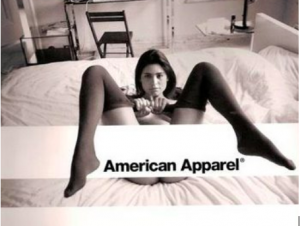One of the most controversial brands of the 21st century, American Apparel originated as a wholesale supplier. It became synonymous with high quality cotton t-shirts and favoured by merchandise printing companies. Soon moving on to becoming one of the largest retailers specialising in preppy American basics, with over 250 stores in 2010.
Responsible for creating and printing their infamous campaigns, American Apparel faced massive criticism for their sexually charged advertisements. While they continuously boast about their ‘Made in USA’ and sweatshop free production, they seem unbothered by the fetishisation of young girls. Continuously romanticising sexual objectification and degrading girls for attention. The lack of airbrushing doesn’t compensate for their psychological scarring on young girls. While sexual liberation is beautiful and should be respected, it shouldn’t be morphed to fit the male fantasy; it should be personal and selfish.
The photograph in mention contains a young woman laid on a neatly made bed in a sparsely decorated room that appears uninhabited and cold. Based on AA’s advertising campaigns, I think this is constructed to resemble the ‘classic bachelor pad’, the girl representing an innocent and willing guest. Wearing nothing but nylon tights slipped down to her knees with her legs in the air. She’s pulling her tights towards her body instead of off her body, as if out of urgency or non-committal convenience. The most disturbing part of this image is that she’s pictured with a completely emotionless expression, as if powerless and trapped. The photograph is predominantly white, the colour of virginal purity, further advocated by the age of the girl; yet her dark features and black stockings reveals a more seductive layer. It’s taken from above, giving the illusion of domination and superiority. The bottom of her breasts and buttocks are in direct eye line down the centre of the image, cleverly placed hands and a bold white logo cover the bare minimum, just enough to be marketable.
While I believe the brands identity was influenced by the style of the 90’s supermodel where child like qualities were favoured: doe-eyed, shapeless, skinny girls with innocent expressions (who were made to model in the nude, in their seemingly pre-pubescent bodies). I think the desire was to capture what the majority of generations wish they still had: youth. While the intention may have been harmless enough, the standardisation and insensitivity of pedophellia and sexual exploitation is unforgivable.
I sometimes imagine American Apparel had Vladimir Nabokov’s ‘Lolita’ (1962) playing continually in the back ground as they brainstormed their advertising campaigns. At the time of this campaign the company solely stocked woman’s clothing, and it disgusts me that they used their massive influence to broadcast this image of a powerless and desperate girl with no other want than to be objectified. Strong and independent is just as sexy, it just puts the power in the woman’s hands. The fetishisation of young girls, or boys, is something that cannot be allowed. We have a moral obligation to protect and defend whats right and wrong, especially when it compromises the safety and happiness of future generations.

